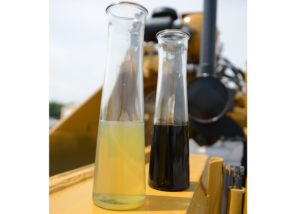Hydraulic Filtration: Hydraulic System Failures
Hydraulic Filtration Systems on Pipe Bending Equipment

New oil is dirty oil and should be the only dirty oil your system ever sees.
As we explained in our previous post, the mineral oil you purchase from your local supplier in your totes or in your 55 gallon drums is dirty. Purchasing clean oil is cost prohibitive for most manufacturers of hydraulic equipment. As the new oil passes through the system the filters will do their job and clean up that dirty new oil. Hence, properly designed hydraulic filtration systems on pipe bending equipment will clean up that dirty oil and bring it within the system requirements for your valves and pumps.
Servicing Intervals
In my post on hydraulic oil I discussed how hydraulic oil servicing intervals should not be established at an arbitrary time frame, but should be checked for depletion and degradation of additives. Similarly, the oil should be checked for cleanliness. Wear particles that are not filtered out of the hydraulic oil can accelerate the degradation of the oil additives.
DMI hydraulic filters are all supplied with visual indicators. Our newly designed equipment is supplied with three micron filtration and a larger dirt holding capacity. With the increased dirt holding capacity of our filters and the reduction of ingression points, the changing intervals of the filters will extend. The efficiency of the filters to remove contamination from the system actually increases as the filter begins to collect dirt. Consideration should be given to the oil cleanliness and the operating conditions of the machine before changing the filter.
System Failures
Almost all hydraulic system failures can be attributed to dirty hydraulic oil. So, where does the contamination in the hydraulic system originate and how does it get into the system? The fine powdery dust found on most right of ways is the number one culprit and there are several points of ingression on pipe bending equipment.
All hydraulic systems require a hydraulic reservoir and these reservoirs are supplied with filler caps and breathers. Some reservoirs are supplied with filler caps that have breathing capability as well. Both of these items are typically supplied with 40 micron filtration levels. For reference, a human hair is about 40 micron in diameter. Hence, selecting the correct components based on the working condition of the equipment is critical.
In the next article we’ll discuss contamination sources in pipe bending equipment a little further.
